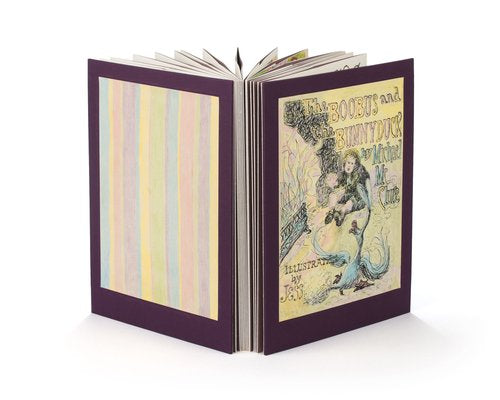The Boobus and the Bunnyduck
The Boobus and the Bunnyduck
Facsimile of a unique artist book made by Jess in 1957 from a children's story by Michael McClure, in accordion-fold format, in box with booklet, 2007. $1,500.00
Publication 80
ADD TO CARTThis is the first publication of a unique artist book made by the artist Jess Collins in San Francisco in 1957. The story was written by poet Michael McClure for his daughter Jane, born in 1956, who was nicknamed “Boobus”. It is his only piece of children’s literature. While it is a children’s book, this is first and foremost an artist book of considerable sophistication. The book was retained by Jess in the Victorian house in the Mission District he shared with the poet Robert Duncan and where he lived until his death.
In the 1950s the McClures were younger friends of Duncan and Jess and frequently visited them at their earlier home, a flat on De Haro Street, where the two were living after their return from Mallorca and Black Mountain College. It is likely that Michael showed them his children’s story in 1956 or 1957 and that Jess took the initiative to illustrate it in crayons. Colored wax crayons, usually thought of as art materials for children, were favored by Jess and Robert for drawings they often made as after-dinner entertainment.
In The Boobus and the Bunnyduck Jess used crayons with the skill of a highly accomplished painter. Even the lettering, as Jess wrote out the story by hand, has a painterly quality that is deceptively naïve.
The name “Boobus” may make one think of a “booby”, usually meaning a dunce or slow-witted person. Here, McClure endearingly uses it for a child not yet conditioned by the world but having intuitive sympathy for other creatures, whatever shapes they may take. Such a child might join two or more animals’ names together, creating a new name, which could account for the “Bunnyduck” in the story.
Jess intrigues the reader (and the child being read to) by repeating phrases from the story on picture pages facing the pages where the phrases are part of sentences but appear to be titles of illustrations. “To see if her”, “up into the”, “and under the”, “but mostly because” lead the viewer to search through the text to find where the words occur and what they mean, revealing the meaning of the picture.
Of special note are the endpapers, entitled “Humble Jumble”. They are in a style very different from the thick, creamy crayon “paintings” and deft ink drawings in the book. Here he has drawn precise outlines of common objects in perspective, filling them with thin, pale tones, applied with crayons but looking more like watercolor washes. We seem to be seeing a cluttered work table in a puzzle-picture designed to teach children the shapes and names of things. Subtly evoking Duchamp and Magritte, the still life is surrounded by a golden thread woven in a Celtic strap-work pattern.
FORMAT
The Boobus and the Bunnyduck is a full-scale, full-color facsimile of the original and unique artist book made by Jess in 1957. The only difference is in the format. Whereas the original was spiral-bound, the facsimile is bound as an accordion-fold. This enables viewers to open the cover and turn pages as in a conventionally bound book, but it also allows the book to be displayed on a table, shelf, or in a vitrine, spread out flat or standing up zig-zag, so that all pages can be seen at once. There are thirty-two panels, twenty-eight for the book proper plus the endpapers, front and back, that are continuous over two panels. The panels measure 13.75 inches high by 10.5 inches wide, so that the book stretches out to 28 feet. The covers are purple cloth over boards with recessed areas for the front and back cover images. On the front Jess wrote out the title, the names of author and artist, with an illustration. On the back he drew vertical bands of color, those used in the book. The formatting and matching of colors were done by Blake Riley for printing with an Epson 4000 inkjet printer on Moab Entrada paper. The backing paper is mauve-white duplex Bugra. The book is enclosed in a box. The edition is limited to 100 numbered copies for sale.
POSTAGE: Additional postage may apply; please inquire for details.
Share

